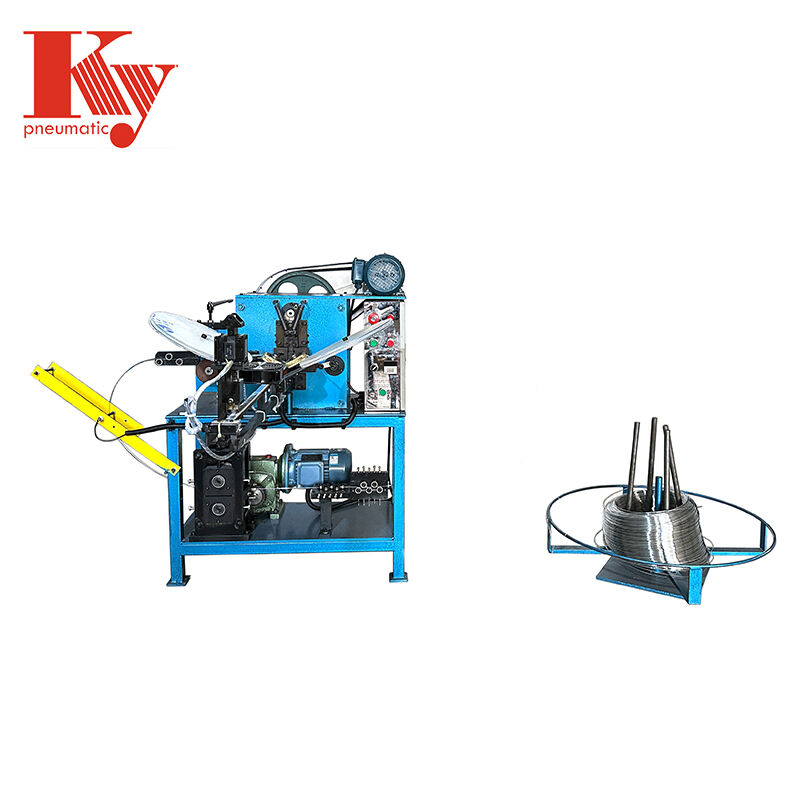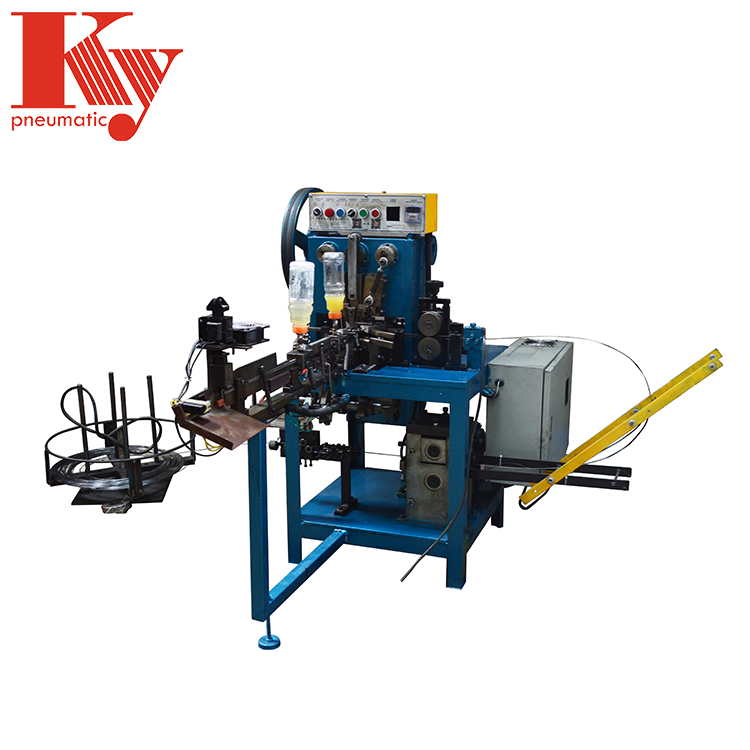The Inner Workings of Staple Machines
Core Mechanics of Staple Machines
The Wire-to-Staple Transformation Process
The conversion from wire to staples involves a meticulous process, ensuring every staple meets quality standards. Most staples are produced from high-tensile steel wires, enabling durability and performance, particularly in industrial contexts. The wire-to-staple transformation includes several key stages: cutting the wire to precise lengths, bending them into the staple shape, and finishing processes like heat treatment for added strength. Studies in the industry highlight how these stages optimize efficiency, reducing waste and increasing output. Quality control plays a pivotal role, with standard measures in place to ensure each staple meets consistent specifications, emphasizing the need for precise manufacturing. Recent technological advancements, such as automation in wire shaping and enhanced drying technology, further enhance efficiency and precision in the staple production process.
Role of Feeding Mechanisms and Precision Molds
Feeding mechanisms in staple machines are crucial for maintaining a steady flow of wire, essential for continuous production. These mechanisms ensure that raw materials are consistently supplied to the machine, preventing interruptions and enhancing overall productivity. Precision molds come into play by shaping the staples, ensuring they have uniform dimensions. This uniformity is essential, as it determines the reliability of staple performance. Various staple machine models offer different feeding mechanisms, each impacting machine performance in unique ways. High-quality molds are integral to product output and accuracy, as supported by industry research, which underscores the importance of consistent staple size and shape in maintaining machine efficiency.
Automated vs Semi-Automated Operation Systems
Automated staple machines differ significantly from their semi-automated counterparts, primarily in terms of operational efficiency and investment. Automated systems typically offer higher productivity and require a larger initial investment, yet they promise a quicker return due to enhanced throughput. According to leading industry analysts, plants employing full automation exhibit increased productivity levels compared to those using semi-automation. However, semi-automated systems still serve a vital role, especially for smaller operations unable to invest in full automation. They offer adaptability and cost-effectiveness, often with simpler designs that can be managed without the need for specialized training. Machines like these exemplify flexibility, allowing businesses to scale their operations without substantial capital investment.
Specialized Staple Machine Variants
Packaging Staple Machines for Carton Sealing
Packaging staple machines are designed with specific features aimed at optimizing carton sealing processes. These machines ensure efficient sealing and fastening by utilizing specialized designs that cater to packaging needs. The advantages of employing specialized machines for packaging processes are evident—they enhance production speed and reduce labor costs significantly. Statistics demonstrate an upward market trend in packaging staple machines, indicating their growing relevance and use. Leading brands like Dongguan Shilong Ky Nailing Equipment Factory are notable players in the market, offering innovative models tailored for specific applications.
High-Carbon Steel Models for Industrial Fastening
High-carbon steel staple models stand out for their durability and are highly suitable for industrial uses such as construction. The benefits of this material include superior tensile strength and longevity, which are supported by laboratory testing results. Market trends indicate a rise in the adoption of high-carbon steel staples in manufacturing environments, as industries value their robustness and efficiency. Case studies highlight various sectors transitioning to high-carbon steel staples, revealing significant improvements in operational effectiveness and reduced maintenance costs.
D-Ring Machines for Animal Cage Construction
D-Ring staple machines offer unique attributes tailored specifically for animal cage construction. These machines are optimized for this application, focusing on material compatibility and ensuring fastening stability. Many industries utilize D-Ring staple machines because they meet stringent environmental and regulatory standards. Testimonials and reviews from users attest to their reliability and effectiveness, solidifying their reputation in this niche market.
Industrial-Grade Staple Machines for Specialized Applications
HR22 D-Ring Staple Machine: Features & Benefits
The HR22 D-Ring Staple Machine stands out in the realm of industrial-grade staple machines due to its robust features and versatile applications. This machine operates independently from the initial wire stage to the final staple, ensuring a streamlined and efficient production process. Notable for its high stability and low noise output, it is an ideal choice for industries such as pet cage manufacturing, furniture, and auto hardware. Utilizing this machine offers significant benefits, including its reliable efficiency, allowing one worker to manage up to five machines simultaneously. Furthermore, intuitive features like an automatic counter and self-adjusting mechanisms make operation straightforward and user-friendly, enhancing both usability and serviceability.
Fully Automatic 4K High-Carbon Steel Staple System
The Fully Automatic 4K High-Carbon Steel Staple System is an advanced staple-making machine that enhances industrial efficiency. With a focus on impeccable speed and output capabilities, this system is designed for the seamless production of high-quality, high-carbon steel staples. Industries such as aluminum and wrought iron furniture manufacturing benefit significantly from this technology, as it minimizes labor costs and maximizes production consistency. The automation ensures precise staple size and shape, controlled to a remarkable 0.1 mm error range, maintaining quality across batches. User testimonials express satisfaction with the system's reliability and the substantial improvements in operational productivity.
Critical Components Ensuring Performance
Precision Straightening Devices Explained
Precision straightening devices are essential in maintaining staple quality and consistency. These devices ensure that the staple wires are uniformly aligned before they are cut and shaped, significantly impacting staple performance. Common types include roller and lever-based devices, each with unique benefits backed by manufacturer specifications. According to research, proper alignment facilitated by precision devices improves staple feeding and efficiency, thereby reducing machine downtime. Innovations like adjustable straightening rollers have further enhanced machine reliability and output, allowing for a smoother operation of complex machinery.
Temperature-Controlled Molding Technology
Temperature-controlled molding technology is vital for optimizing staple production, as heat plays a crucial role in determining staple characteristics. Without precise temperature control, the staples could become brittle or unevenly formed. Studies in the industry have consistently shown that maintaining the correct temperature improves the durability and consistency of produced staples. Technologies such as thermoregulated molds or induction heating coils offer efficient temperature control, leading to better performance metrics. Case studies in manufacturing environments reveal substantial improvements in quality and production speed upon integrating such technologies.
Error-Rated Feed Systems (±0.1mm Accuracy)
Error-rated feed systems are crucial for the accuracy of staple production, with systems capable of maintaining precision to within ±0.1mm, a standard for high-quality outputs. Data from performance reports demonstrate that staple machines with such accuracy yield significantly fewer rejects when compared to systems with less precision. The underlying technology relies on optical sensors and servo-driven motors to ensure exact wire positioning, thus enhancing production precision. For businesses, this improved accuracy translates to cost savings, enhanced product quality, and increased customer satisfaction, serving as a strong competitive advantage in the marketplace.
Maintenance & Efficiency Optimization
Routine Cleaning Procedures for Longevity
Routine cleaning is crucial for extending the lifespan of staple machines and maintaining their optimal performance. Regular cleaning helps prevent excessive wear and tear on critical components, such as the precision straightening devices and feed systems. To ensure efficient operation, follow these steps:
- Power Off: Begin by safely powering off the machine to avoid accidents during cleaning.
- External Wipe Down: Use a lint-free cloth to remove dust and debris from the exterior surfaces.
- Straightening Device Check: Carefully inspect and clean the precision straightening devices to ensure they are free from obstructions.
- Feed System Maintenance: Clean all moving parts of the feed system to prevent jamming.
- Internal Inspection: Open the machine's casing to clean internal parts with a compressed air blower.
- Lubrication: Apply lubricant to essential components post-cleaning to maintain smooth function.
Experts emphasize the advantage of regular maintenance. Findings show that consistent cleaning practices significantly increase the longevity and reliability of staple machines.
Troubleshooting Common Jamming Issues
Understanding the common causes of staple machine jamming can help operators reduce downtime and optimize performance. Frequently, issues arise due to poor material quality or mechanical failures associated with feed systems. Here are effective troubleshooting steps:
- Material Inspection: Ensure materials are consistent and meet quality standards. Low-quality staples may cause jams.
- Proper Alignment: Check staple alignment within the feeder to prevent misfires.
- Clearing Blockages: If jamming occurs, promptly clear any blockages in the feed path.
- Component Check: Regularly inspect moving parts for wear or damage that could lead to jams.
- Calibration Tests: Run calibration tests to ensure mechanism precision.
Implementing these preventive measures can avoid costly downtime. Manufacturers underscore the importance of routine checks to anticipate and avoid potential jamming issues.
Upgrading Mold Sets for Different Staple Profiles
Mold sets play an essential role in producing various staple profiles tailored to specific applications. Upgrading these molds can significantly enhance production adaptability and efficiency. When selecting new molds, consider the following:
- Material Compatibility: Choose molds that align with the staple materials to ensure quality production.
- Volume Requirements: Evaluate production capacity to select molds that meet demand scalability needs.
Upgrading molds involves careful planning and execution. By adopting mold upgrades, industries can efficiently respond to evolving demands, enhancing both the efficiency and quality of staple production. Many industries heavily benefit from such upgrades, adapting to varying market conditions seamlessly.

 EN
EN
 AR
AR
 BG
BG
 CS
CS
 FI
FI
 FR
FR
 DE
DE
 EL
EL
 HI
HI
 IT
IT
 JA
JA
 KO
KO
 PL
PL
 PT
PT
 RU
RU
 ES
ES
 TL
TL
 ID
ID
 LT
LT
 SR
SR
 UK
UK
 VI
VI
 SQ
SQ
 GL
GL
 HU
HU
 MT
MT
 TH
TH
 TR
TR
 AF
AF
 MS
MS
 AZ
AZ
 KA
KA
 BN
BN
 LO
LO
 LA
LA
 MI
MI
 MN
MN
 NE
NE
 KK
KK
 UZ
UZ


